Shanghai Today
Shanghai Accelerates Ancient Shipwreck Salvage - July 17, 2022
上海加速清朝沉船打捞
The world’s first workboat named Fenli, tailor-made for the salvage of the ancient shipwreck, Yangtze River Estuary Boat No. 2, was completed and arrived in Shanghai on July 15, The Paper learned from Shanghai Administration of Culture and Tourism. Dali, the primary workboat for the excavation project, returned to the port on July 6 after completing the pre-processing work on site. Both workboats have made a major breakthrough in the salvage and relocation work, which is the core of the archaeology and heritage conservation of Yangtze River Estuary No.2.
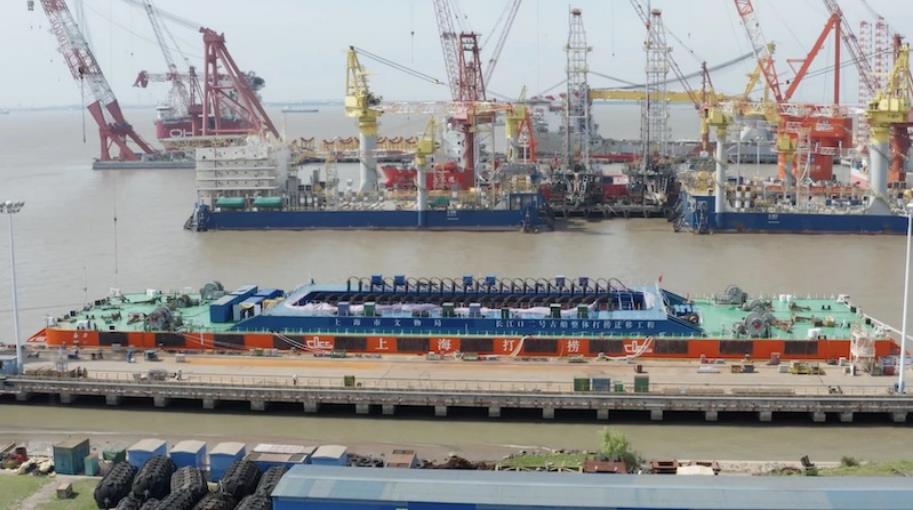
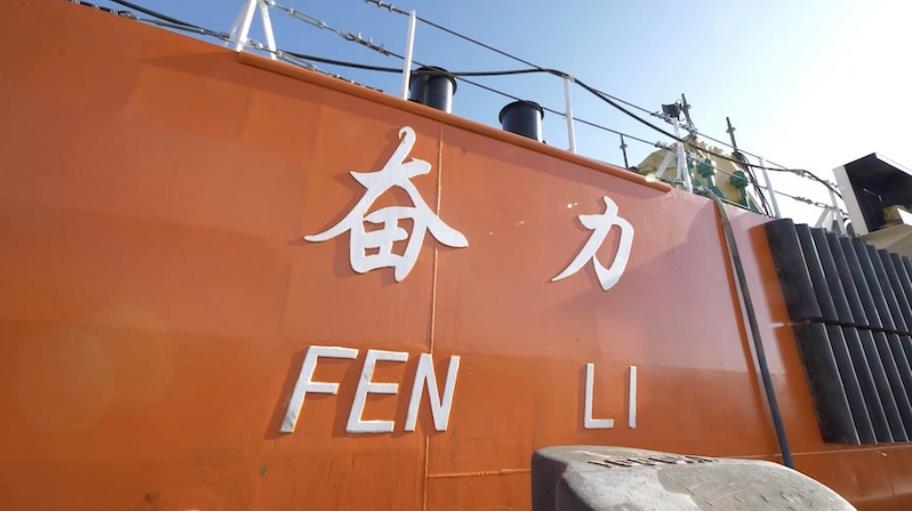
Yangtze River Estuary No.2 is a wooden sailing boat built during the reign of Emperor Tongzhi, in the Qing Dynasty. Its discovery is another milestone in China’s underwater archaeology after the Nanhai No.1 shipwreck of the Song dynasty was found 35 years ago.
In March, soon after the official launch of the archaeological and cultural relics protection of Yangtze River Estuary No. 2, Shanghai encountered the current wave of the pandemic, which affected the whole work progress. Shanghai Administration of Culture and Tourism, together with other departments and units including the Shanghai Salvage Bureau of the Ministry of Transport, promoted the resumption of the project in a strict and orderly manner by integrating resources and optimizing the program while ensuring the quality of work and construction safety. On May 9, the processing of the special arc beam resumed. On June 1, Dali, which is responsible for the overall relocation of Yangtze River Estuary No.2, set sail for the pre-processing work. After fulfilling its work, Dali returned to port on July 6. The new workboat Fenli completed production in Nantong of Jiangsu province and delivered back to Shanghai on July 15.
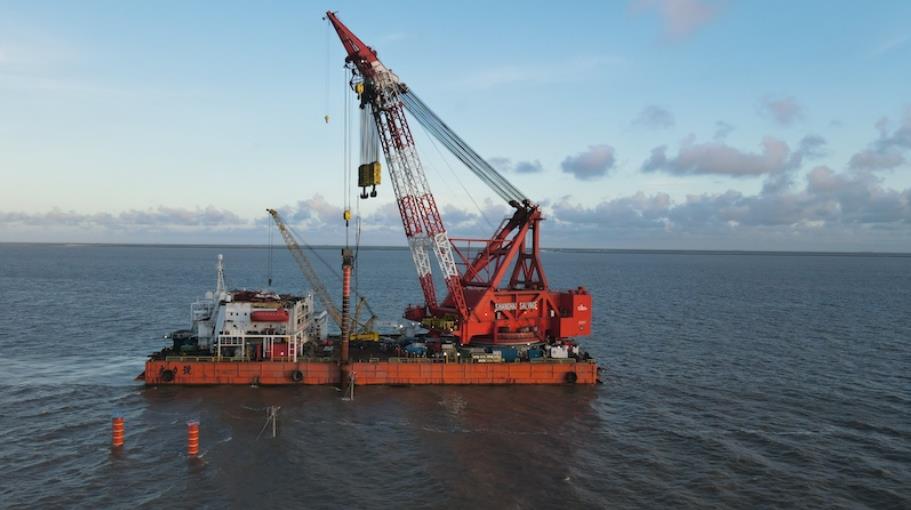
On June 1, Dali left the port and carried out the pre-salvage cleanup work on the site of Yangtze River Estuary No. 2. Guided by the National Administration of Cultural Heritage, the Shanghai Administration of Culture and Tourism, together with Shanghai Salvage Bureau, gathered professionals in the fields of archaeology, diving, geophysical prospecting and salvage engineering to combine marine geophysical scanning and diving exploration. After 35 days of continuous work, they accurately located the boundaries and burial depth of the ancient ship and confirmed its size to be about 38.1 meters in length, 9.9 meters wide, with the prow facing south. In strict accordance with the underwater archaeological work specifications, the group carried out the archaeological cleanup of the cultural heritage items in the sinking areas of arc beam top frame design, extracting the rudder (rudderstock and tiller), iron anchor, ropes, construction materials, a purple clay teapot, and other scattered relics. By doing so, they have minimized the loss of scattered cultural relics in the subsequent salvage stage, ensuring the integrity of the ancient shipwreck.
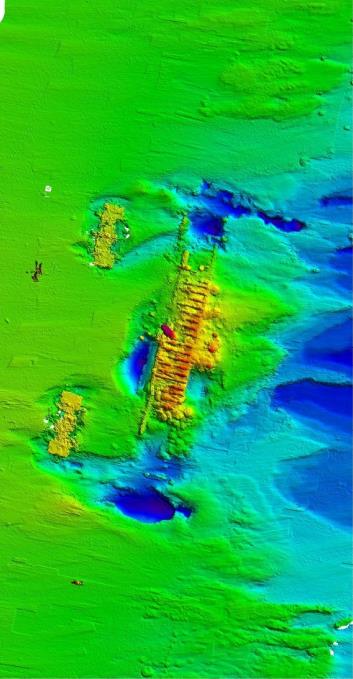
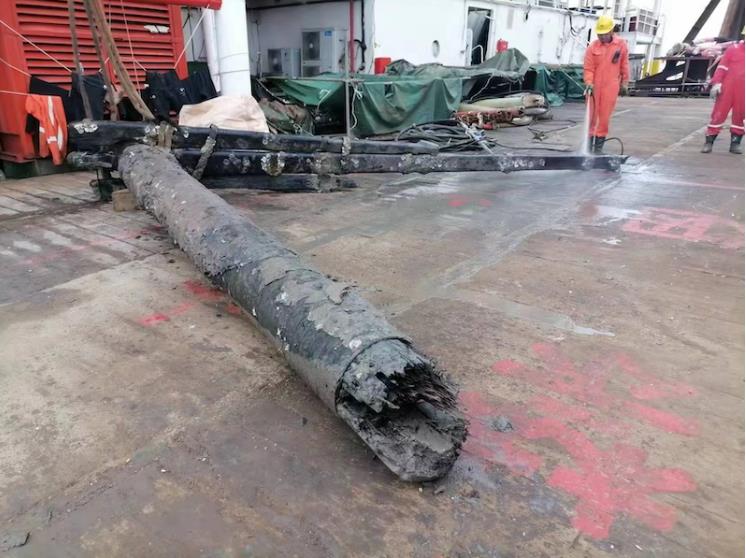
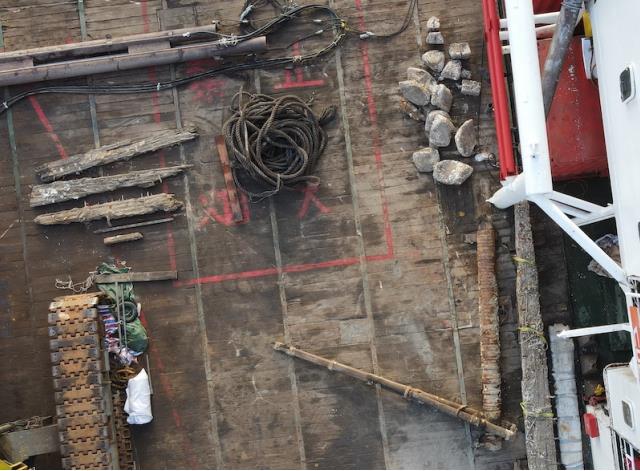
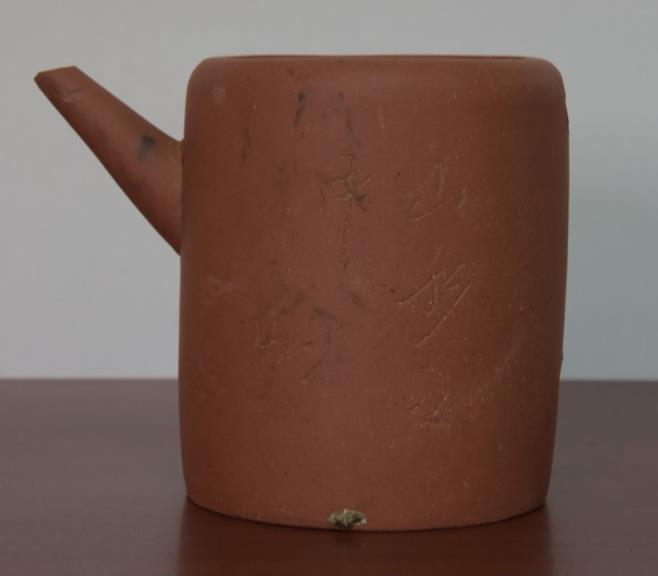
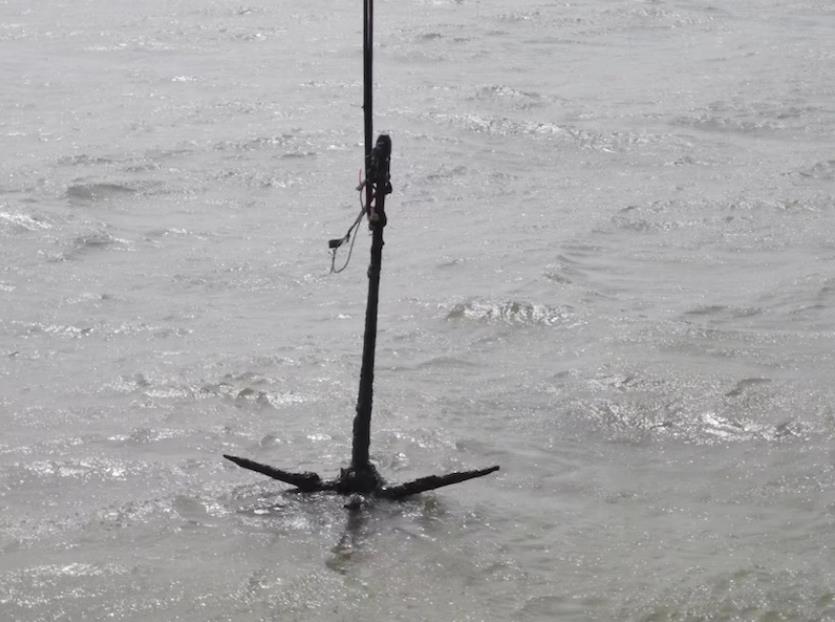
In late June, multibeam fine scanning of the ancient ship was completed under the scorching sun. Experts clarified the sinking location of the arc beam end plate and pre-excavated two end plate sinking trenches of 20 meters in length, 1.3 to 3 meters in width, and more than 3 meters in depth, which eliminated potential obstacles for the subsequent overall salvage of the end plate.
On July 5, at the site of the ancient shipwreck, Dali completed the sinking of four spuds with high quality. According to the surveyors, the verticality of the spuds was less than 0.5% and the absolute position error was less than 31 centimeters, both meeting the design requirements. This marked the successful completion of the pre-processing stage of the overall relocation of Yangtze River Estuary No. 2.
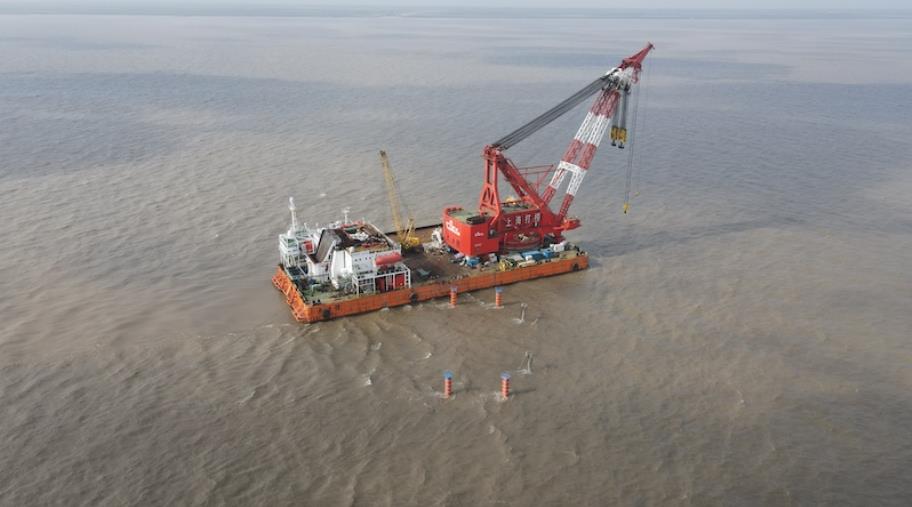
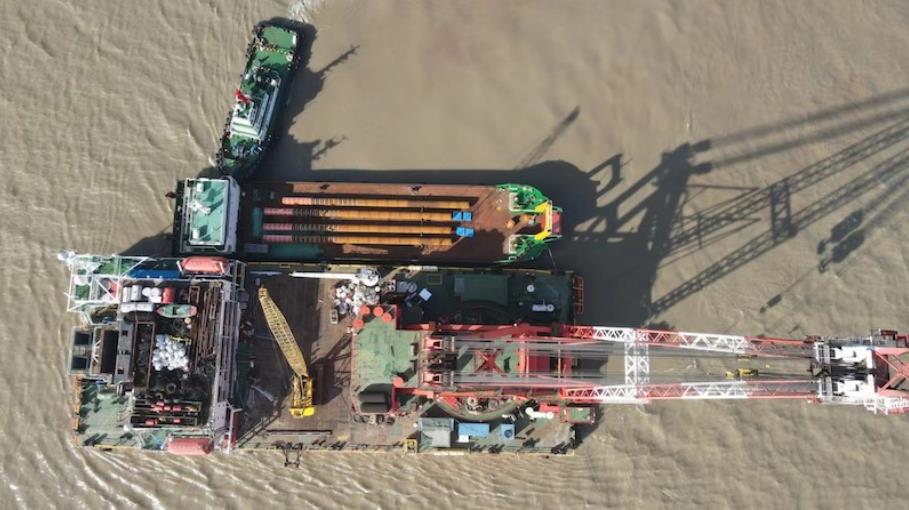
To ensure the safe and complete salvage and relocation of Yangtze River Estuary No. 2, the Shanghai Administration of Culture and Tourism, together with the Shanghai Salvage Bureau of the Ministry of Transport, designed a brand-new workboat and named it Fenli.
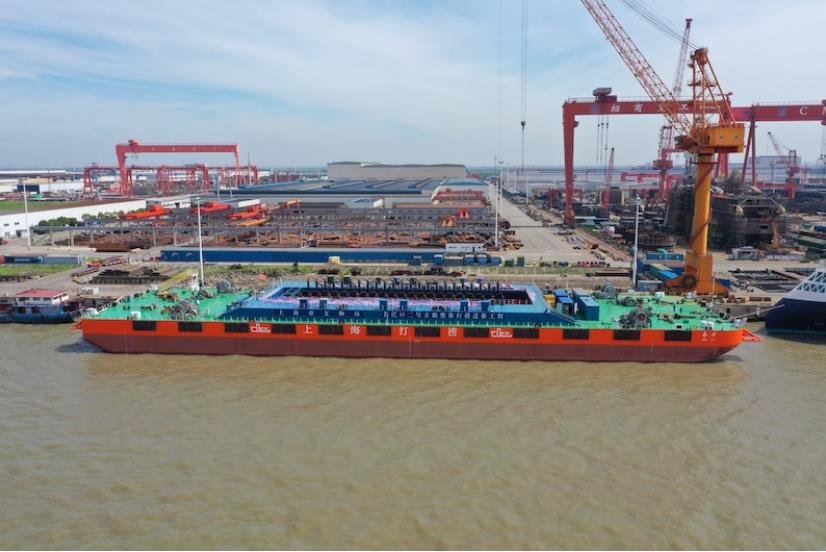
On March 10, Fenli started its construction in Nantong. On April 12, the keel of the ship was laid together. On May 26, the ship was launched from the dock. Despite the outbreak of the pandemic, it was delivered to Shanghai on July 15, nearly one month ahead of schedule.
The main scale of Fenli is 130 meters long, 34 meters wide, 9 meters deep, and with a design draft of 6 meters. The most important feature is that the ship is equipped with synchronous lifting devices at both ends and an opening in the middle of the ship with a moon-pool of 56 meters long and 20 meters wide. This design enables the ship to directly lift the ancient ship from the bottom of the sea to the moon-pool, then transport and unload it to Shanghai Shipyard No.1 dock, completing triple tasks with only one ship, greatly improving the operational efficiency and ensuring the safety of the cultural relics in the construction process.
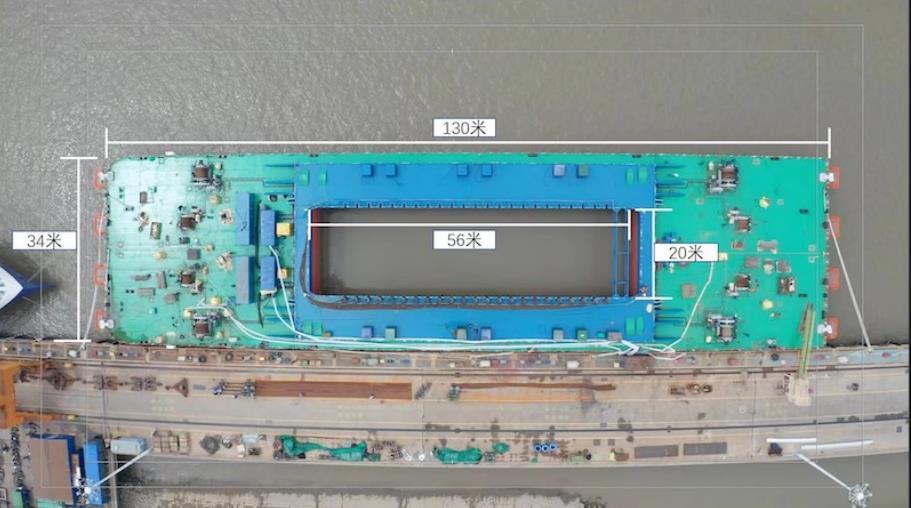
Fenli, which integrates lifting, transporting, docking and unloading, has a moon-pool opening like a kangaroo mother’s pocket to protect the ancient ship’s hull, belongings, and cultural relics on board, which plays a fundamental role in the subsequent synchronous archaeological excavation and the display and utilization of cultural relics. In addition, Fenli has the advantages of high safety, strong operability, and high tech. The hull is specially designed for the overall salvage and relocation project of Yangtze River Estuary No. 2. It provides new methods for future engineering research and sets up a new model of overall relocation technology.
The return of Dali and the delivery of Fenli will accelerate the overall salvage and relocation project of Yangtze River Estuary No.2. After a short rest, Dali will go to Hengsha Base Wharf to assemble the end plate frame of the arc beam. In the second half of August, Dali is expected to set sail back to the ancient ship site, officially carry out the salvage construction operations and get it out of the water as soon as possible, to solve the puzzles hidden in the ancient ship.
Source: The Paper


Yangtze River Estuary No.2 is a wooden sailing boat built during the reign of Emperor Tongzhi, in the Qing Dynasty. Its discovery is another milestone in China’s underwater archaeology after the Nanhai No.1 shipwreck of the Song dynasty was found 35 years ago.
In March, soon after the official launch of the archaeological and cultural relics protection of Yangtze River Estuary No. 2, Shanghai encountered the current wave of the pandemic, which affected the whole work progress. Shanghai Administration of Culture and Tourism, together with other departments and units including the Shanghai Salvage Bureau of the Ministry of Transport, promoted the resumption of the project in a strict and orderly manner by integrating resources and optimizing the program while ensuring the quality of work and construction safety. On May 9, the processing of the special arc beam resumed. On June 1, Dali, which is responsible for the overall relocation of Yangtze River Estuary No.2, set sail for the pre-processing work. After fulfilling its work, Dali returned to port on July 6. The new workboat Fenli completed production in Nantong of Jiangsu province and delivered back to Shanghai on July 15.

On June 1, Dali left the port and carried out the pre-salvage cleanup work on the site of Yangtze River Estuary No. 2. Guided by the National Administration of Cultural Heritage, the Shanghai Administration of Culture and Tourism, together with Shanghai Salvage Bureau, gathered professionals in the fields of archaeology, diving, geophysical prospecting and salvage engineering to combine marine geophysical scanning and diving exploration. After 35 days of continuous work, they accurately located the boundaries and burial depth of the ancient ship and confirmed its size to be about 38.1 meters in length, 9.9 meters wide, with the prow facing south. In strict accordance with the underwater archaeological work specifications, the group carried out the archaeological cleanup of the cultural heritage items in the sinking areas of arc beam top frame design, extracting the rudder (rudderstock and tiller), iron anchor, ropes, construction materials, a purple clay teapot, and other scattered relics. By doing so, they have minimized the loss of scattered cultural relics in the subsequent salvage stage, ensuring the integrity of the ancient shipwreck.





In late June, multibeam fine scanning of the ancient ship was completed under the scorching sun. Experts clarified the sinking location of the arc beam end plate and pre-excavated two end plate sinking trenches of 20 meters in length, 1.3 to 3 meters in width, and more than 3 meters in depth, which eliminated potential obstacles for the subsequent overall salvage of the end plate.
On July 5, at the site of the ancient shipwreck, Dali completed the sinking of four spuds with high quality. According to the surveyors, the verticality of the spuds was less than 0.5% and the absolute position error was less than 31 centimeters, both meeting the design requirements. This marked the successful completion of the pre-processing stage of the overall relocation of Yangtze River Estuary No. 2.


To ensure the safe and complete salvage and relocation of Yangtze River Estuary No. 2, the Shanghai Administration of Culture and Tourism, together with the Shanghai Salvage Bureau of the Ministry of Transport, designed a brand-new workboat and named it Fenli.

On March 10, Fenli started its construction in Nantong. On April 12, the keel of the ship was laid together. On May 26, the ship was launched from the dock. Despite the outbreak of the pandemic, it was delivered to Shanghai on July 15, nearly one month ahead of schedule.
The main scale of Fenli is 130 meters long, 34 meters wide, 9 meters deep, and with a design draft of 6 meters. The most important feature is that the ship is equipped with synchronous lifting devices at both ends and an opening in the middle of the ship with a moon-pool of 56 meters long and 20 meters wide. This design enables the ship to directly lift the ancient ship from the bottom of the sea to the moon-pool, then transport and unload it to Shanghai Shipyard No.1 dock, completing triple tasks with only one ship, greatly improving the operational efficiency and ensuring the safety of the cultural relics in the construction process.

Fenli, which integrates lifting, transporting, docking and unloading, has a moon-pool opening like a kangaroo mother’s pocket to protect the ancient ship’s hull, belongings, and cultural relics on board, which plays a fundamental role in the subsequent synchronous archaeological excavation and the display and utilization of cultural relics. In addition, Fenli has the advantages of high safety, strong operability, and high tech. The hull is specially designed for the overall salvage and relocation project of Yangtze River Estuary No. 2. It provides new methods for future engineering research and sets up a new model of overall relocation technology.
The return of Dali and the delivery of Fenli will accelerate the overall salvage and relocation project of Yangtze River Estuary No.2. After a short rest, Dali will go to Hengsha Base Wharf to assemble the end plate frame of the arc beam. In the second half of August, Dali is expected to set sail back to the ancient ship site, officially carry out the salvage construction operations and get it out of the water as soon as possible, to solve the puzzles hidden in the ancient ship.
Source: The Paper
Application Status
| 04-16 | 21315227 | Processing |
| 03-12 | 21315226 | Processing |
| 09-26 | 21315225 | Processing |
Inquiry Status
| 02-29 | 02131558 | Received |
| 03-06 | 02131557 | Received |
| 11-14 | 02131556 | Received |
FAQ
Q: Q: Is there a place where I can get...
A: A: Log on to http://touch.shio.gov....
A: A: Log on to http://touch.shio.gov....
Q: Q: What is the easiest way to set u...
A: A: 1. Log on to http://touch.shio.g...
A: A: 1. Log on to http://touch.shio.g...
Q: Where can I get an English map of S...
A: English maps of Shanghai are availa...
A: English maps of Shanghai are availa...

